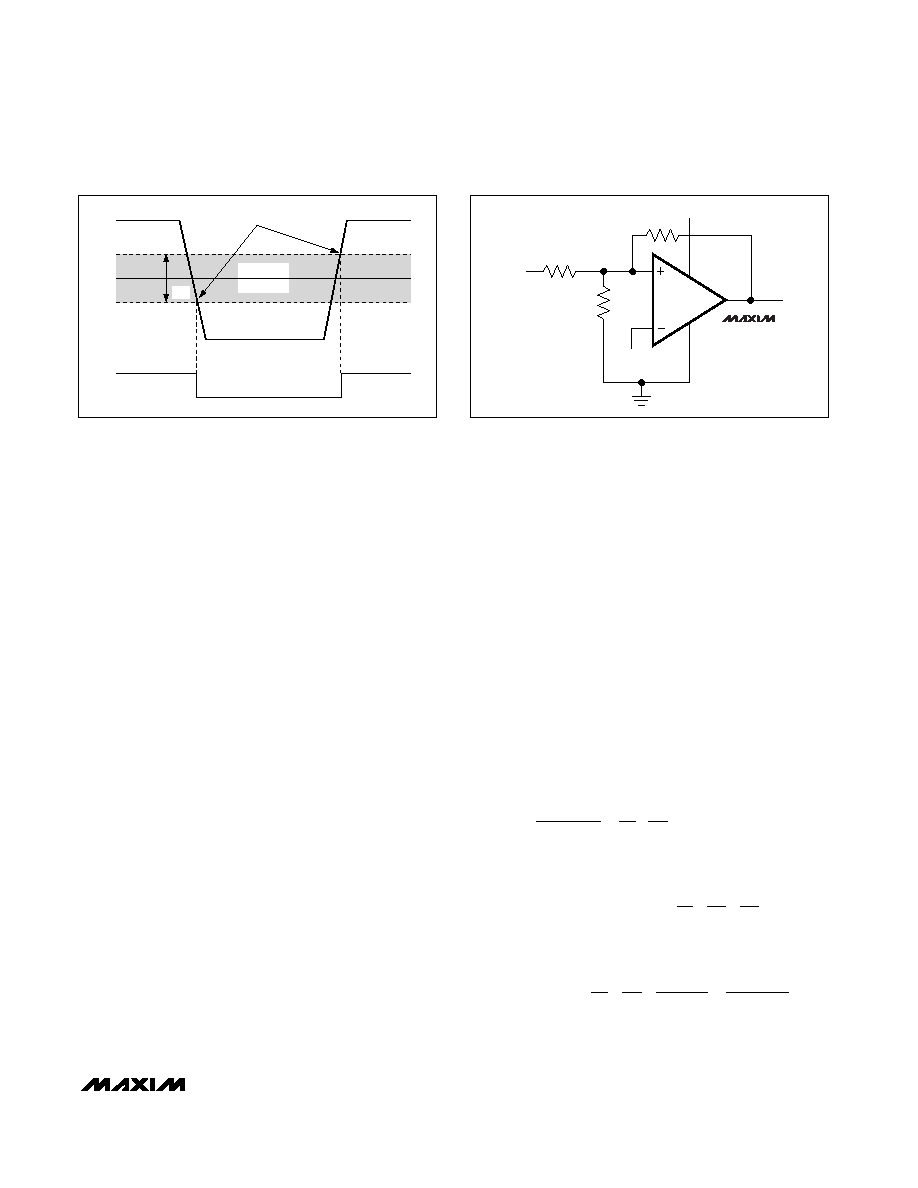- 您現(xiàn)在的位置:買(mǎi)賣(mài)IC網(wǎng) > PDF目錄67324 > 5962-8686103XC (MAXIM INTEGRATED PRODUCTS INC) 1-OUTPUT THREE TERM VOLTAGE REFERENCE, 2.5 V, MBCY3 PDF資料下載
參數(shù)資料
| 型號(hào): | 5962-8686103XC |
| 廠(chǎng)商: | MAXIM INTEGRATED PRODUCTS INC |
| 元件分類(lèi): | 基準(zhǔn)電壓源/電流源 |
| 英文描述: | 1-OUTPUT THREE TERM VOLTAGE REFERENCE, 2.5 V, MBCY3 |
| 封裝: | METAL CAN-3 |
| 文件頁(yè)數(shù): | 3/14頁(yè) |
| 文件大小: | 336K |
| 代理商: | 5962-8686103XC |
第1頁(yè)第2頁(yè)當(dāng)前第3頁(yè)第4頁(yè)第5頁(yè)第6頁(yè)第7頁(yè)第8頁(yè)第9頁(yè)第10頁(yè)第11頁(yè)第12頁(yè)第13頁(yè)第14頁(yè)

MAX9117–MAX9120
SC70, 1.6V, Nanopower, Beyond-the-Rails
Comparators With/Without Reference
______________________________________________________________________________________
11
THRESHOLDS
OUT
IN+
IN-
VHB
HYSTERESIS
BAND
VTHF
VTHR
Figure 2. Threshold Hysteresis Band
VCC
MAX9117
MAX9119
OUT
R3
R1
R2
VREF
VEE
VIN
VCC
Figure 3. MAX9117/MAX9119 Additional Hysteresis
MAX9117 (VREF = 1.252V) and VCC = +5V, and if
we choose IR3 = 1A, then the two resistor values
are 1.2M
and 3.8M. Choose a 1.2M standard
value for R3.
2) Choose the hysteresis band required (VHB). For this
example, choose 50mV.
3) Calculate R1 according to the following equation:
R1 = R3 (VHB / VCC)
For this example, insert the values:
R1 = 1.2M
(50mV / 5V) = 12k
4) Choose the trip point for VIN rising (VTHR) such that
VTHR > VREF (R1 + R3) / R3, (VTHR is the trip point
for VIN rising). This is the threshold voltage at which
the comparator switches its output from low to high
as VIN rises above the trip point. For this example,
choose 3V.
5) Calculate R2 as follows:
R2 = 1 / [VTHR / (VREF R1) - (1 / R1) - (1 / R3)]
R2 = 1 / [3.0V / (1.252V 12k
) - (1 / 12k) -
(1 / 1.2M
)] = 8.655k
For this example, choose an 8.66k
standard 1% value.
6) Verify the trip voltages and hysteresis as follows:
VIN rising: VTHR = VREF R1 [(1 / R1) + (1 / R2)
+ (1 / R3)] = 3V
VIN falling: VTHF = VTHR - (R1 VCC / R3) = 2.95V
Hysteresis = VTHR - VTHF = 50mV
Additional Hysteresis (MAX9118/MAX9120)
The MAX9118/MAX9120 have a 4mV internal hysteresis
band. They have open-drain outputs and require an
external pullup resistor (Figure 4). Additional hysteresis
can be generated using positive feedback, but the for-
mulas differ slightly from those of the MAX9117/
MAX9119. Use the following procedure to calculate
resistor values.
1) Select R3 according to the formulas R3 = VREF / 1A
or R3 = (VCC - VREF) / 1A - R4. Use the smaller of
the two resulting resistor values.
2) Choose the hysteresis band required (VHB).
3) Calculate R1 according to the following equation:
R1 = (R3 + R4) (VHB / VCC)
4) Choose the trip point for VIN rising (VTHR) (VTHR is
the trip point for VIN rising). This is the threshold volt-
age at which the comparator switches its output
from low to high as VIN rises above the trip point.
5) Calculate R2 as follows:
6) Verify the trip voltages and hysteresis as follows:
Hysteresis = VTHR - VTHF
V
falling
VV
R
RR
R
RR
V
IN
THF
REF
CC
:
=×
+
+
×
1
2
1
34
1
34
Vri
g
V
R
RR
R
IN
THR
REF
sin :
=×
+
1
2
1
3
R
V
VR
R
THR
REF
21
1
3
=
×
/
相關(guān)PDF資料 |
PDF描述 |
|---|---|
| 5962-87591013X | 1-CH 12-BIT SUCCESSIVE APPROXIMATION ADC, PARALLEL ACCESS, CQCC28 |
| 5962-8759101LX | 1-CH 12-BIT SUCCESSIVE APPROXIMATION ADC, PARALLEL ACCESS, CDIP24 |
| 5962-87591023X | 1-CH 12-BIT SUCCESSIVE APPROXIMATION ADC, PARALLEL ACCESS, CQCC28 |
| 5962-87591043X | 1-CH 12-BIT SUCCESSIVE APPROXIMATION ADC, PARALLEL ACCESS, CQCC28 |
| 5962-8759402YA | 1-OUTPUT TWO TERM VOLTAGE REFERENCE, 2.5 V, CDSO10 |
相關(guān)代理商/技術(shù)參數(shù) |
參數(shù)描述 |
|---|---|
| 5962-8686202RA | 制造商:Integrated Device Technology Inc 功能描述: |
| 59628686301XC | 制造商:AMD 功能描述:AM29116/BXC |
| 596286864011A | 制造商:ALTERA 功能描述:EP600DM883B |
| 59628686401XA | 制造商:ALTERA 功能描述:EP600JM883BX |
| 59628686501CA | 制造商:TI 功能描述:SNJ54ALS10AJ |
發(fā)布緊急采購(gòu),3分鐘左右您將得到回復(fù)。